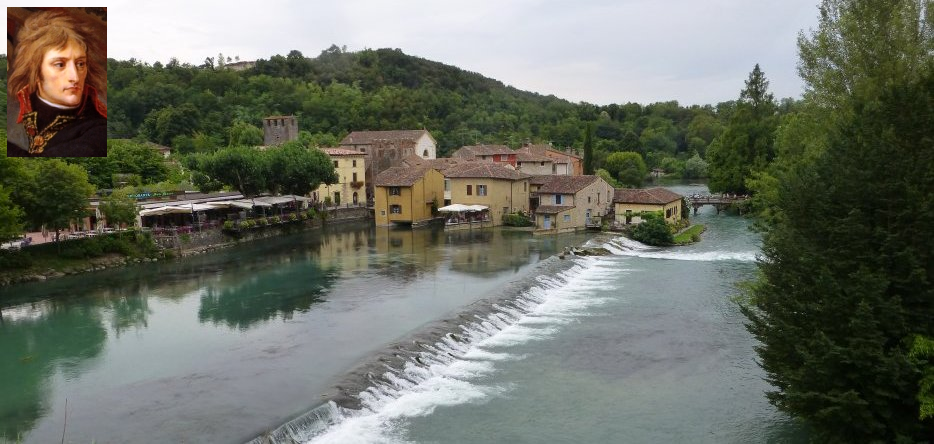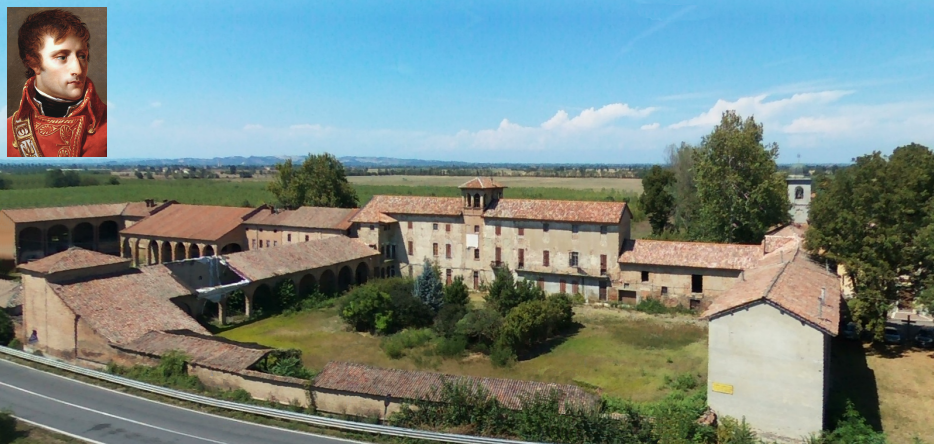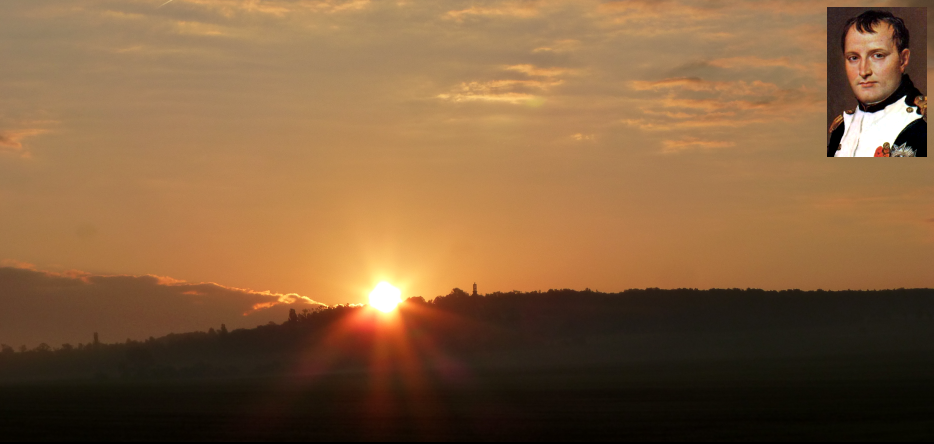Napoleon Bonaparte outside France
Napoleon Bonaparte is certainly one of the heads of state who spent the most time outside France.
From the Campaign in Italy of 1796-1797, then the Egyptian Campaign in 1798-1799, he demonstrated his military genius beyond the country's borders. Under the Consulate, he repeated this feat beyond the Alps. Finally, during the Empire, campaigns, both glorious and tragic, were central to the epic.
But Napoleon was also keen, once in power, to visit parts of his national territory that are now located abroad; we have chosen to include these visits in our statistics as well.
However, we have not taken into account days spent at sea, due to the difficulty of attributing them to a particular country (territorial waters at that time were only three nautical miles wide, approximately the range of a cannon).
In total, no fewer than twenty countries or territories outside the borders of France today experienced the arrival or passage of Napoleon Bonaparte; some for long periods (Italy, Germany, Egypt), others very briefly (Luxembourg, Slovenia, Slovakia, Hungary).
General Bonaparte's Campaigns
This period began on December 22, 1793, when Napoleon Bonaparte was promoted to the rank of brigadier general, and ended on November 9, 1799, with the Coup d'Etat of 18 Brumaire.

It was in Northern Italy that General Bonaparte spent the most time.
He initially served there for 50 days in the spring and then in the summer of 1794 when, as a young general, he commanded the artillery of the Army of Italy.
Once at the head of the entire Army of Italy, between April 3, 1796 (entry into Liguria from Menton ) and November 20, 1797, the day he left the country:
- Napoleon waged war in Liguria, Piedmont, Lombardy, and Veneto for no less than 380 days, initially during the Italian campaign;
- He entered Austrian territory (34 days in Austria, then 2 in Slovenia) on March 28, 1797, and remained there until April 29, 1797. The following day, he was informed of Austria's ratification of the preliminaries of the Peace of Leoben, which ended the Italian campaign itself;
- He then organized his conquest starting on May 1, 1797, spending 201 more days in Italy, until November 20, 1797.
After leaving Italy, Napoleon returned to France, then Switzerland (4 days) and Baden (1 day) in order to reach Rastadt [Rastatt, present-day Germany], on the right bank of the river Rhine , where he briefly participated (6 days) in the congress held there.
On December 2, 1797, he returned to French soil.
In February 1798, he spent four days in Belgium (Furnes, Nieuwpoort, Ostend, Ghent, Antwerp, Brussels ) during an inspection tour as General of the Army of England. He concluded that, given the state of the ports and garrisons, a cross-Channel expedition would be risky.
That same year, in April, Napoleon was entrusted by the French Directory with command of the Army of the Orient, created for an expedition to Egypt, then under Ottoman rule. The transport fleet set sail from Toulon on May 19, 1798. From June 10 to 18, Bonaparte was in Malta, which was quickly conquered, and then set sail again for Egypt.
The landing in Egypt took place during the night of July 1st to 2nd, 1798. Napoleon would not leave the country until August 22, 1799. In the meantime, the Syrian Expedition was conducted from February 24 to May 31, 1799, in the present-day territories of the Gaza Strip and the State of Israel, as far as Acre [Akko] .
The Campaigns and Visits of the First Consul
This period began on November 10, 1799, the day after the coup d'état of 18 Brumaire; on that day, Napoleon was elected provisional consul along with Emmanuel-Joseph Sieyès and Pierre Roger-Ducos. It ended on May 17, 1804, the eve of the senatus-consultum that proclaimed Napoleon Bonaparte Emperor of the French.

As soon as he had the destiny of the country in his hands, Napoleon Bonaparte set about putting an end to the Second Coalition. To do this, he had to defeat the Austrians of Francis II, Emperor of the Holy Roman Empire. He left in early May 1800, arrived in Switzerland on May 8, and after 12 days crossed the Great St. Bernard Pass and entered Italy. He remained there until June 27 (a total of 38 days), inflicting the Austrians defeats at Montebello and Marengo .
In the summer of 1803, the First Consul set out on an inspection tour of the northern regions of the Republic (present-day Belgium and the Netherlands), accompanied by his wife Joséphine, between July 9 and August 4 (27 days in total, including 4 in the Netherlands). The couple received a warm welcome from the population.
The Campaigns and Visits of the Emperor of the French
The Empire spanned two periods. The first one, which lasted ten years, began on May 18, 1804, the day of the senatus consultum proclaiming Napoleon Bonaparte Emperor of the French; It ended on April 5, 1814, the date of the first abdication of Napoleon at the Château de Fontainebleau . The second one, called "the Hundred Days", began on March 20, 1815, the day Napoleon returned from his exile on the island of Elba entered Paris, settled in the Tuileries Palace and formed his government; it ended with his new abdication on June 22, 1815, four days after the defeat at Waterloo.

The Emperor's foreign visits can be roughly divided into three categories, each with very different relative importance: military campaigns, visits to the Empire's provinces and territories, and diplomatic trips.
Military Campaigns
These campaigns occupied a prominent place both in Napoleonic legend and in the length of his stays abroad. No fewer than eight campaigns saw Napoleon I fight outside the Empire's borders:
- The German campaign of 1805, which after the victories of Elchingen and Ulm culminated in Austerlitz [Slavkov u Brna] , saw Napoleon spend 62 days in Germany, 42 in Austria, and 27 in what is now the Czech Republic;
- The Prussian campaign of 1806 ended with the double victory of Auerstaedt and Jena . On this occasion, Napoleon spent 64 days in Germany;
- The Polish campaign, from November 1806 to July 1807, immediately followed, the two battles of Eylau and Friedland taking place in East Prussia [nowadays the Kaliningrad Oblast, belonging to the Russian Federation, and northern Poland]. The countdown is as follows: 42 days in present-day Russia, 194 days in Poland, then 8 days in Germany for the return to France;
- The Peninsular War provided the Emperor with the opportunity to intervene in Spain in 1808 and 1809, notably fighting the Battle of Somosierra , north of Madrid. Between crossing the Pyrenees on the outward and return journeys, a total of 85 days were spent;
- The Austrian campaign in 1809 saw the Emperor win at Eckmühl [Eggmühl] in Bavaria, and then be held in check at Aspern-Essling , to finally triumph at Wagram [Deutsch-Wagram] , these last two battles having as their scene the banks of the Danube River [Donau] , very close to Vienna [Wien] . During this campaign, Napoleon spent 42 days in Germany, 162 in Austria, 6 in what is now the Czech Republic, 1 in Hungary, and 1 in Bratislava, Slovakia;
- The Russian Campaign, in 1812, began for Napoleon personally in Lithuania (30 days), after an approach through present-day Germany (19 days) and Poland (14 days), then continued in Belarus (53 days) and Russia (111 days). On the way back, it was again Poland (6 days) and Germany (4 days), crossed quickly and discreetly to reach Paris as quickly as possible;
- The Saxon campaign of 1813, whose defeat at Leipzig was the turning point for Napoleon, saw the latter spend a total of 209 days in Germany, 18 in Poland, and 4 in the Czech Republic;
- Finally, during the period known as the Hundred Days, the Belgian Campaign of 1815 took place over a period of six days in a country that had become foreign again since the previous year. The defeat at Waterloo brought the Napoleonic Wars to a definitive end.
Visits to the Provinces and Territories of the Empire
Throughout his reign, the Emperor dutifully visited the people of the Empire, whose territorial peak was between 1811 and 1813, as well as the Kingdom of Italy, of which he was sovereign. The regions visited, now outside French territory, were the subject of the following stays:
- 6 days in Belgium in 1804, then 15 in 1810 and 7 in 1811;
- 1 day in the Netherlands in 1804, then 8 days in 1810 and 34 in 1811;
- 1 day in Luxembourg in 1804;
- 37 days in Germany in 1804;
- 81 days in Italy in 1805, then 39 in 1807.
Diplomatic Travels
Imperial diplomacy, finally, saw Napoleon I himself visit twice Present-day Germany:
- 23 days in 1808, to go to Erfurt, Saxony, to meet the Emperor of Russia Alexander I to strengthen the Franco-Russian alliance concluded the previous year by the Treaty of Tilsit;
- 8 days in 1811, for a courtesy visit to the new Grand Duke Charles-Louis of Baden, husband of Stéphanie de Beauharnais.
Summary table
This table lists the number of days Napoleon spent in each country (or territory, in the case of Gaza), according to its current borders, by period (French Revolution, Consulate, and Empire).
| Current country (or territory) | General Bonaparte | First Consul | Emperor of the French | TOTAL |
|---|---|---|---|---|
| 1106 | 84 | 1491 | 2681 | |
| 34 | 0 | 204 | 238 | |
| 0 | 0 | 53 | 53 | |
| 4 | 26 | 36 | 66 | |
| 0 | 0 | 37 | 37 | |
| 318 | 0 | 0 | 318 | |
| 7 | 0 | 475 | 482 | |
| 0 | 0 | 1 | 1 | |
| 89 | 0 | 0 | 89 | |
| 631 | 39 | 126 | 796 | |
| 0 | 0 | 30 | 30 | |
| 0 | 0 | 2 | 2 | |
| 7 | 0 | 0 | 7 | |
| 0 | 4 | 54 | 58 | |
| 9 | 0 | 0 | 9 | |
| 0 | 0 | 234 | 234 | |
| 0 | 0 | 153 | 153 | |
| 0 | 0 | 1 | 1 | |
| 2 | 0 | 0 | 2 | |
| 0 | 0 | 85 | 85 | |
| 5 | 15 | 0 | 20 |
Crédit photos
Photos by Lionel A. Bouchon.Photos by Marie-Albe Grau.
Photos by Floriane Grau.
Photos by Didier Grau.
Photos by Michèle Grau-Ghelardi.